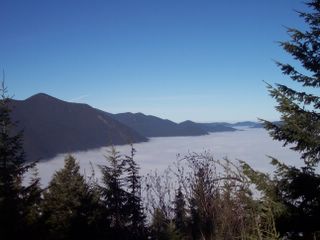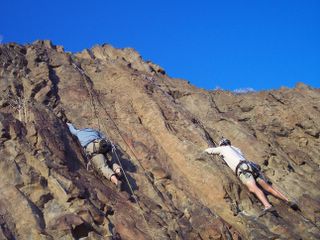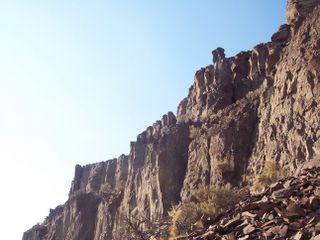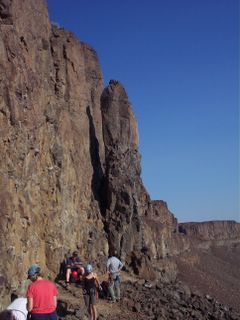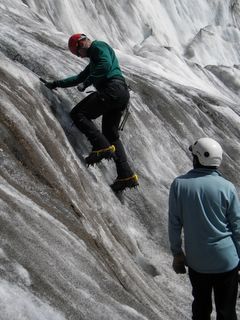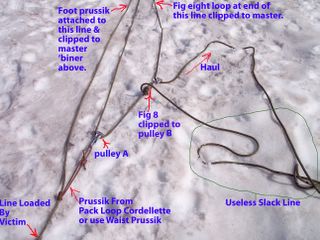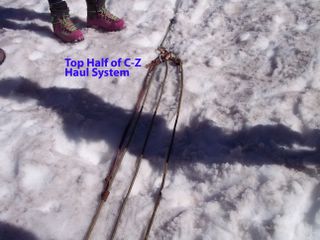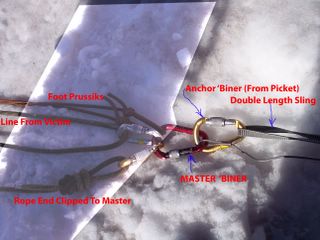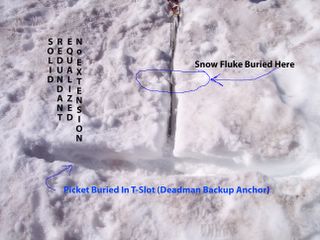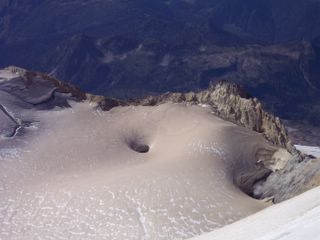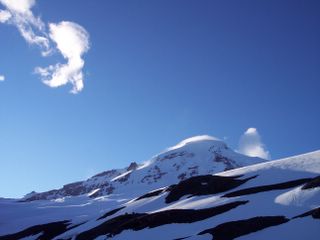
Mt Baker Summit (View From Base Camp)

The following is a trip report of my Mt Baker summit attempt via the Coleman-Deming climber’s route. The summit attempt was part of a 3-day crevasse rescue; glacier travel course taught by American Alpine Institute (AAI) guide Scott Schumann, beginning Sunday, 5 June, and ending on summit attempt day, 7 June 2005. Scott led a 5 client team on this Mt Baker odyssey. Scott’s mountaineering skills, judgments, and wisdom shaped a valuable wilderness adventure for our entire team.
Day1: At the trailhead (3700 feet), after donning full rain gear, our team commenced hiking in a steady downpour through an old growth forest on the Heliotrope Trail. Veering right we traveled the climber’s route to the Coleman Glacier, destined for Hogsback Base Camp. Nearing the base camp, precipitation changed from rain to wet snow. Arriving on the Hogsback (about 6000 feet elev.), we set up base camp in a snowing, chilly whiteout.

Whiteout Advancing On Hogsback Base Camp

Suddenly, as the sun burned through the thick whiteness, the whiteout cleared revealing stunning views of the Mt Baker summit, Coleman and Roosevelt Glaciers, the Heliotrope Ridge, and a cloud covered valley below. Rejoicing at our good fortune, we smirked upon noticing that Bellingham and the greater Puget Sound remained completely socked-in, enveloped by clouds below us. How could those dwelling below us, our friends, acquaintances, and loved ones, ever appreciate our good fortune? Trust me when I tell you that the Goddess of Mt Baker cares little for smirking, would-be climbers.

Coleman Glacier - View From Base Camp

Minutes after taking photographs and congratulating ourselves, the whiteout and winds returned - temperatures dropped from “sun-baking” warm to bitter cold. Retiring early to our tents, we suffered through a night so frigid, it was truly impossible to stay warm.
Day 2: Waking early, we broke camp in the bitter cold with another whiteout advancing upon us. Departing base camp, we roped-up and ascended the right fork of Coleman Glacier, establishing High Camp on the glacier at 7800 feet, between Heliotrope Range and Black Buttes. All day long whiteouts would come and go, producing conditions alternating from bright, clear sky, intense sunshine to frigid, wind-driven whiteness. We experienced forms of icy snow-hail precipitation mankind has yet to name. We were surprised on two separate occasions this day, as rope team members dropped waist deep into narrow, snow-covered crevasses on the Coleman Glacier (without injury and almost self-extricating).

Looking Toward Black Buttes From High Camp

With High Camp established early, we spent the remainder of the afternoon practicing glacier travel and crevasse rescue techniques, absorbing much wisdom from Scott, our AAI guide and mentor. The weather continued to cycle. Around 6 PM however, the whiteout became sustained, temperatures dropped to “miserably frigid”, and we were pelted by millions of tiny snow-hail crystals. At about 9 PM we ducked into our tents, gaining relief from the weather and resting for our subsequent day 3 alpine summit start. I must confess, at this point we were not optimistic that a summit attempt would even be remotely possible unless the weather changed dramatically.
Day 3: The weather changed dramatically. Waking at 1:15 AM, we emerged from our tents into a beautifully clear, starry night – the summit attempt was back on track. Three to four inches of fresh snow had deposited overnight, so we elected to not don crampons (Crampons were worn later at the bottom of Pumice Ridge). Without breaking camp, we shouldered our summit packs, roped-up, and commenced climbing above High Camp, ascending past the Black Buttes, Colfax Peak, up the Pumice Ridge, onto the Upper Deming Glacier, to the Baker Headwall at 9800 feet elevation, our turnaround point.
Why did we turn around instead of advancing up the headwall to Mt Baker’s summit (10,781 feet)? Well…remember that smirking climber story? Yeah, the weather changed 45 minutes after leaving high camp. The starry night became an intense, frigid, sustained whiteout. Climbing through the whiteout to the top of Pumice Ridge and the base of the Baker Headwall, we decided to wait 20 minutes for the whiteout to subside. Wind speed at this point was around 40 mph. We only waited 10 minutes before deciding to scrub the summit attempt. One team member was becoming hypothermic, it was clear that the weather would only worsen if we proceeded to the summit, and we still had to navigate through the whiteout all the way back down the mountain.
Scrubbing the summit attempt at 9800 feet was a wise decision. The whiteout worsened and winds thrashed us mercilessly as we began the real adventure – navigating through the whiteout back to High Camp. Scott led our rope team back to High Camp using every mountaineering trick ever devised. Observing Scott, I learned our safe return resulted from his steady, unflustered application of mountaineering principles, an accumulation of similar mountaineering experiences, and application of sound judgment and leadership under such adverse conditions.
As we safely returned to High Camp, the Goddess of Mt Baker continued to exhibit no mercy. Pelted by freezing snow-hail, with visibility of about 15 feet, we rapidly broke camp. Hastily stuffing all remaining gear into our soggy backpacks, we roped-up and continued down the mountain, descending the Coleman Glacier to the Hogsback, still navigating under whiteout conditions. One team member punched through a thin snow crust, dropping waist-deep into a narrow, very deep, hidden crevasse. Wedged between the narrow crevasse lips, his thick backpack prevented him from plunging further into the chilly abyss. Unable to extricate himself due to the thin surrounding snow crust, the rope team setup a belay and Scott hauled him out of the crevasse (grabbing his backpack and pulling him out).
Although arduous and wet, the march down the Hogsback to the Heliotrope Ridge trail, was uneventful relative to all preceding events of the day. Returning to the trailhead, we drove to AAI headquarters in Bellingham and exchanged farewells with our fellow team members and guide. This three day adventure was an experience to be treasured.
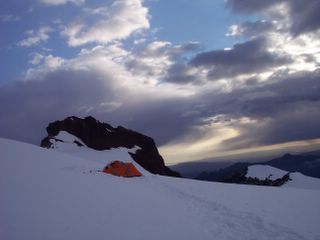
Sunset At Highcamp





